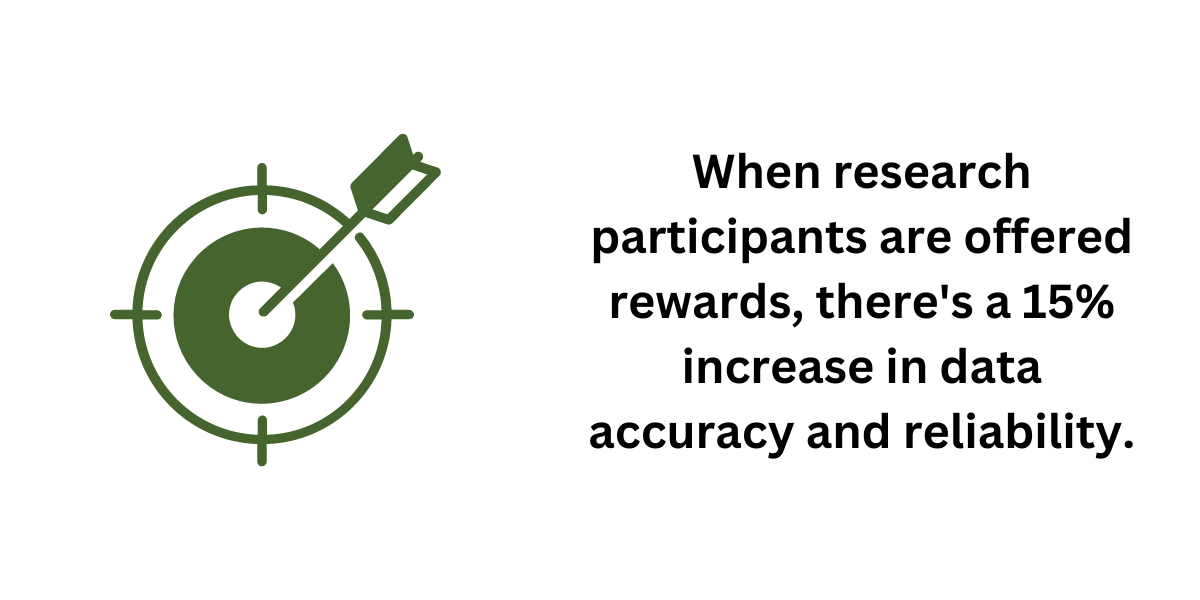Optimizing UX Research Incentives: 4 Essential Steps


by Signe Hegart
August 24, 2023
User experience (UX) research is a critical step in designing and improving products and services. By understanding the needs, preferences, and behaviors of users, companies can create experiences that are intuitive, enjoyable, and satisfying. However, conducting effective UX research requires the participation of users, which can often be a challenge. This is where UX research incentives come into play. Incentives play a crucial role in encouraging users to participate in research studies and providing them with a positive experience. In this guide, we will explore the importance of UX research incentives and provide you with 4 essential steps to optimize their effectiveness.
Jump to
A lot of people ask whether offering some sort of incentive for people to participate in a study will bias the results. The answer is, “not if done correctly.“
What is UX research incentives and why does it matter?
UX (User Experience) research incentives refer to rewards, compensation, or benefits offered to individuals who participate in user experience research activities. UX research involves gathering insights and feedback from users to improve the design, functionality, and overall experience of products, services, or systems. Incentives are used to motivate individuals to take part in these research activities, such as
- Usability testing
- Surveys
- Interviews
- Focus groups
The goal of offering incentives in UX research is to encourage participation, ensure a diverse and representative participant pool, and gather high-quality and honest feedback from users.
By providing incentives, organizations aim to create a win-win situation:
Participants receive something valuable in exchange for their time, thoughts and respondent, and organizations receive valuable insights that can lead to better-designed products or services.
Studies also shows that the participants are more likely to return to a survey increased by 30% for those who received an incentive offer
However, it’s important to design incentive strategies thoughtfully, taking into account participant motivations, ethical considerations, and the goals of the research.

Which types of incentives exist?
1. Monetary Incentives : These are cash-based rewards that can range from a small payment to a substantial amount. Monetary incentives are often effective in attracting a wide range of participants and ensuring their commitment.
2. Non-Monetary Incentives: These are rewards that are not directly linked to money but still provide value to participants. Examples include gift cards, discounts on products or services, charitable donations, or entry into prize draws. Non-monetary incentives can be particularly appealing to participants who are not motivated solely by money and are looking for other types of rewards.
3. Experiential Incentives: These incentives focus on providing participants with unique experiences or opportunities. For example, participants may be invited to attend exclusive events, test new products before they are released to the public, or receive personalized recommendations. Experiential incentives can create a sense of excitement and exclusivity, motivating participants to actively engage in the research process.
Related: Gift Card vs Cash: Which Is The Better Option?
Step 1. Setting the goals
Before implementing incentives, it is important to define your goals and objectives for the research study. Consider what you hope to achieve, who your target participants are, and what you want them to get out of the research experience. By setting clear goals, you can determine the appropriate types and amounts of incentives to offer.
But what does it mean to set goals for UX research incentives and what is the most popular method?
- Defining research objectives; Before designing incentive strategies, it’s crucial to have a clear understanding of the goals of the UX research. These goals could include improving product usability, identifying pain points, enhancing user satisfaction, or optimizing specific features.
- Linking incentives to objectives; Each incentive should have a purpose tied to the research objectives
- Determining recruitments motivations; To set effective goals, it’s important to understand what motivates participants to engage in the research.
- Balancing value and effort; Goals should take into account the effort participants are expected to invest in the research. The incentive’s value should reflect the time, complexity, and commitment required from participants.
- Measurable outcome; Goals should be quantifiable and measurable.
- Ethical considerations; Ensure that the goals set for incentives are ethical and respect participants’ rights. Goals should not push participants beyond their comfort zones or compromise their data privacy.
- Adaptability; Incentive goals might need to be adjusted based on the progress of the research, the level of participation, or unforeseen circumstances. Flexibility is important to ensure that the goals remain relevant and attainable.
Tip: Gathering Participant Feedback on Incentives
After the Research is Complete:
Once you’ve concluded your user experience research, don’t let the opportunity for further insight slip away. Leverage the enthusiasm and engagement of your participants by asking for feedback on the incentives they received as a token of appreciation. This step holds significant potential to enhance your research methodology, optimize future incentive programs, and build stronger relationships with your participant base.
Step 2. Understanding participant motivations
To design effective incentives, it is crucial to understand the motivations and needs of your target participants. Consider what would incentivize them to participate in a research study. Are they motivated by financial rewards, the opportunity to influence product development, or the chance to try new products? By understanding participant motivations, you have the knowledge to tailor your incentives to meet their needs and increase their willingness to participate.
Psychological factors that can motivate the participant can be:
– Social influence
– Personal relevance
– Competition
– Fear of missing out (FOMO)
– Fun and engagement
Step 3. Designing effective strategies
Once you have identified participant motivations, it’s time to design your incentive strategy. Consider the following to optimize the effectiveness of your incentives:
1. Segmentation
Consider segmenting your participant pool and offering different incentives to different groups based on their motivations. For example, if some participants are motivated by financial rewards, offer them monetary incentives, while offering experiential incentives to those who are motivated by unique experiences.
2. Personalization
Customize your incentives based on individual preferences and needs. This can be done by collecting data on participants’ preferences and tailoring the incentives accordingly. For example, if a participant has expressed interest in a particular product or service, offer them a discount or a free trial as an incentive.
With the freedom of choice gift card that Hurray offers, you are able to let the participant globally choose after their own choice among more than 5000+ options and in more than +100 countries.
3. Gamification
Incorporate elements of gamification into your incentive strategy to make the research process more engaging and enjoyable for participants. This can include adding challenges, rewards, and leaderboards to create a sense of competition and achievement.
Read also: 3 Ways Study Gift Cards Enchance Your Research Program

Step 4. Segment and personalization
Segmentation and personalization are crucial aspects of designing effective UX research incentives. They involve understanding the varied motivations and preferences of participants and tailoring incentives to different user segments. Here’s how you can figure out segmentation and personalization in UX research incentives:
Audience Analysis: Begin by thoroughly understanding your target audience for the research. Collect demographic data, behavioral patterns, preferences, and any other relevant information that can help create distinct user segments.
User Persona Development: Develop user personas that represent different segments of your target audience. Each persona should encompass demographic details, motivations, goals, and pain points. This will help you identify distinct incentive preferences.
Segment Identification: Based on the collected data, segment participants into groups that share common characteristics, motivations, or preferences. These segments could be based on age, profession, experience level, or other relevant factors.
Testing and Iteration: Pilot test your incentive strategies with a small group from each segment. Gather feedback and iterate on your approach to ensure it resonates with participants.
Flexible Options: Offer flexibility within your incentives. For example, allow participants to choose between monetary compensation, product discounts, or donations to a charity.
Measurement and Analytics: Set up metrics to track the effectiveness of each incentive strategy within different segments. Analyze participation rates, completion rates, and the quality of insights provided.
Read also: Boosting Innovation and Results: The Power of Incentives in Research
What are the benefits of offering incentives for UX research?
Offering incentives for UX research can bring numerous benefits for both the researchers and the participants. Here are some key advantages of providing incentives:
- Increased participation rates
- Enhanced participant engagement
- Diverse participant pool
- Improved data quality
- Greater participant satisfaction
- Competitive advantage
Read also: Academic Research Incentives: How, Where And When Does It Work?

Send yourself a gift card
How can UX research incentives be tracked and measured for success?
UX research incentives can be tracked and measured for success by implementing a few key strategies. Here are some steps you can take to effectively track and measure the success of your UX research incentives:

Define clear and measurable goals
Before you can track and measure the success of your UX research incentives, it’s important to define clear goals and objectives. Determine what you hope to achieve with your incentives, such as increasing participation rates, improving the quality of feedback, or increasing user engagement. These goals will serve as benchmarks for measuring success.

Use analytics and data tracking tools
Utilize analytics and data tracking tools to monitor and measure the effectiveness of your UX research incentives. These tools can provide valuable insights into participant behavior, such as click-through rates, completion rates, and user engagement. By tracking these metrics, you can assess the success of your incentives and make data-driven decisions for future improvements.

Conduct post-study surveys
After the completion of a UX research study, it’s important to gather feedback from participants to assess the effectiveness of the incentives. Send out post-study surveys to participants to understand their satisfaction levels, their perception of the incentives, and whether the incentives influenced their willingness to participate. This qualitative feedback can provide valuable insights into the success of your incentives.

Compare results to previous studies or benchmarks
To determine the success of your UX research incentives, compare the results to previous studies or industry benchmarks. Look for patterns or trends in participant behavior and compare them to past data
Conclusion
In conclusion, UX research incentives play a crucial role in driving successful research studies. By understanding the different types of incentives, setting clear goals, and designing effective strategies, companies can enhance participant engagement, improve data quality, and gain a competitive advantage in the market. Tracking and measuring the success of UX research incentives can be achieved through defining clear goals, utilizing analytics and data tracking tools, conducting post-study surveys, and comparing results to previous studies or benchmarks. By continuously evaluating and optimizing incentive programs, companies can ensure that their UX research efforts are impactful and yield valuable insights for the development of user-centered products and services.



Let’s have a chat
FAQ
Paying participants for UX research involves several essential steps. Start by selecting a convenient payment method, such as cash, gift cards, PayPal, or checks. Determine a fair compensation amount based on time and effort.
Transparently communicate compensation details in recruitment materials and consent forms. Collect payment information with explicit participant consent and prioritize data security.
Ensure participants complete required tasks before processing payments promptly. Confirm payments with acknowledgment emails to build trust.
Offer support for payment-related queries and address issues promptly. Request feedback on the payment process to improve participant experience.
Maintain accurate records of compensation details and follow legal and ethical guidelines. By following these steps, you can ensure fair and respectful participant compensation for your UX research.
Here are some few ideas for survey incentives:
- Gift Cards: Offer popular gift cards to online retailers, coffee shops, or restaurants. These are versatile and allow participants to choose rewards that suit their preferences.
- Cash Prizes: Provide cash incentives or the chance to win a cash prize through a lottery or raffle at the end of the survey period.
- Exclusive Content: Offer access to exclusive content, such as whitepapers, e-books, or research reports, relevant to the survey topic.
- Early Access: Grant participants early access to a new product, feature, or service that’s relevant to your industry.
- Charitable Donations: Give participants the option to donate their incentive to a charity of their choice. This adds a philanthropic dimension to your survey.
Ethical considerations are vital when using incentives in research. Uphold participant rights, privacy, and transparency. Clearly explain the incentive structure during informed consent. Participation should be voluntary, without coercion. Ensure fair compensation that matches participants’ efforts. Safeguard privacy and confidentiality when collecting incentive-related data. Avoid harm and discomfort due to the incentive. Provide equitable access to incentives for all participants. Be cautious with sensitive topics, avoiding pressure to disclose uncomfortable information. Do not use deceptive incentives or ones that could sway responses. Prevent undue influence on participants’ decisions. Assess the long-term impact of incentives, especially on vulnerable populations. Ensure participants understand incentives and provide informed consent. Encourage feedback and address concerns about incentives. After research, debrief participants about goals and outcomes. Seek IRB approval for incentive plans when required. Ethical incentive use fosters trust, respect, and meaningful research.